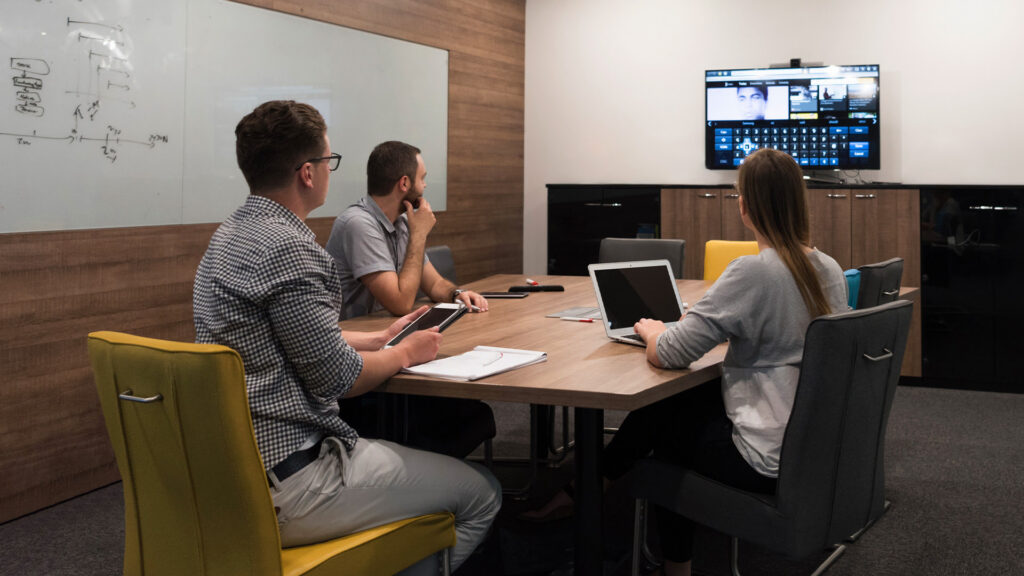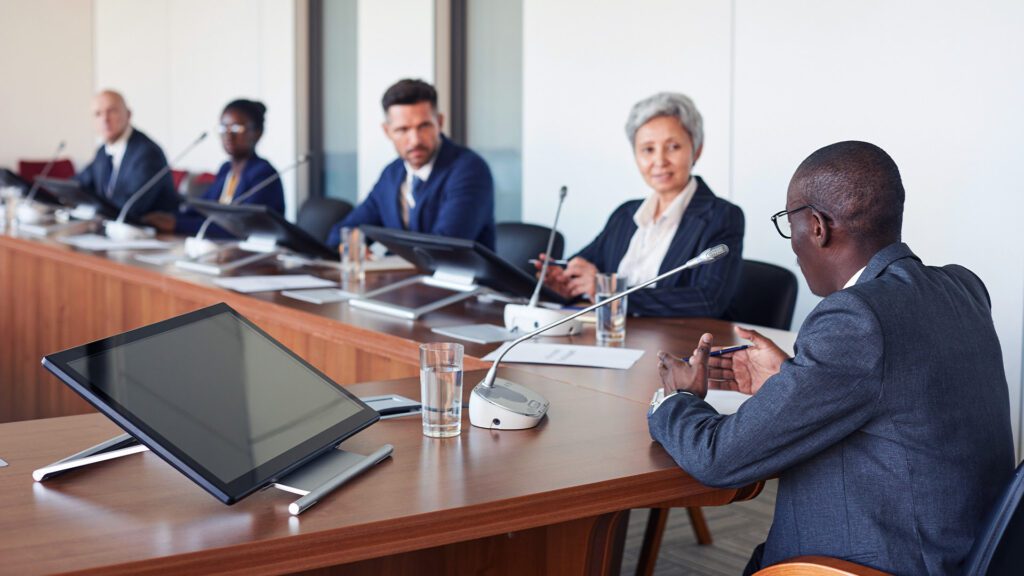Exploring the new reality of a hybrid workplace. One which allows the flexibility of employees working between home, office, and remote locations.
When asked how he would describe 2020, David Kerr, ET Group’s Unified Communications and Collaboration Specialist replies “exceptional and unprecedented.”
On any given workday in 2019, David would be designing and implementing Unified Communications solutions for a variety of large Canadian organizations. Fast forward to present day and his workday remains fairly unchanged. While most organizations found the requirements of social distancing a major challenge to their continued daily operations, ET Group did not. In his five years with the company, David has been a part of the ET Group team that works on designing, integrating, and optimizing clients unified communications and collaboration environments. The kind of hybrid environments that allow working from anywhere, whether at home, in the office, or completely remote.
Work is no longer about where you do it, it’s about what you do and how it gets done.
Hybrid is the future workspace
Organizations have mobilized work from home infrastructure and policies that have forever shaped the way we approach work. Now that the dust has begun to settle, they are collectively looking to the future once again. As companies explore shifting their workers back to the office. They are also envisioning what a flexible workplace might mean to their long-term workplace strategies.
- How will our workplace strategies and technology strategies need to change?
- How will our office evolve to integrate and include the remote workers?
- What technologies will support flexible working between the office, home, and remote locations?
- How will we enable our people to convene for group work?
David is part of the HybridX innovation team at ET Group. He has witnessed and assisted in the architecture of workplace communications firsthand. He is proud to share that, “We’re not afraid of doing remote work and using remote technologies. We’ve been demonstrating it for years. It works, I mean, we’re thriving.”
Workplace and tech strategies are changing
Having worked with many clients to implement their technology strategies to transition to an integrated modern-day workspace. David reflects on the success in leading others to their ideal connected and collaborative work environment, both physically and virtually. “We’re (ET Group) currently experiencing what we’ve been already living for the past few years. Covid has forced us (society) to put it into place now to some degree. By living it, it gives us great advantages in terms of being able to share the experience with others and see what the potential could be.”
“73% of employees want their company to embrace flexibility (working both remotely and in office) post COVID-19.”
Mckinsey Report – June 2020
David has noted the required changes that companies have begun making to their workplace strategies:
- Increased prioritization of workplace technology within business. Organizations need to have a technology strategy that can evolve for the future.
- Intuitive tools; Organizations should be able to define their desired user experience with the technology they are choosing.
- Reliable and user-friendly video communications. Organizations are now in a video first culture that requires high quality audio and visual performance along with an easy to use platform.

Prioritizing flexible, collaborative technology
David has also witnessed some setbacks for companies who did not prioritize flexible and collaborative technology tools within their operations. He remarks at the number of companies who were unprepared to work remotely this year. “It was really quite surprising to me but it’s not all that uncommon. It seems that some companies are still kind of slow to change and Covid has really exposed that.”
David listed some fundamentals items every organization will need for a hybrid workspace:
- Laptops – Companies should ensure their teams have laptops for mobility vs. desktops. HD built in cameras are critical.
- Webcams – Companies should ensure team members have working high resolution video tools for home offies.
- Secure Communications – Companies should invest in secure software and platforms to maintain privacy.
- Remote work connections like a VPN – Companies should invest in a virtual private network.
- Headsets or Audio Boxes – Quality sound and audio for meetings. Forget the basic headphones.
- Data Sovereignty -Companies should be familiar with the location of their servers and data and be aware of any privacy laws relating to the storage of their information.
Challenges of going to a hybrid workplace
As part of ET Group’s HybridX innovation team, David works on identifying and resolving the human challenges of collaboration, communication, and connection using technology. “There were a lot of users that weren’t ready for this. From the standpoint of some users – technology kind of makes them afraid.” Increasing team adoption, training, and comfort levels with technology is critical to overall success when transitioning to working flexible between the office and at home.
When implementing new technology into a hybrid environment, David notes some things to consider are:
- Get feedback from your team on their desired user experience and ease of use. What do they need from the technology to get their work done?
- Ensure you fully understand what the technology will allow you to do and not do. Research your options and assess reliability.
- Find a good consultant to work with your leadership team and determine the technology roadmap that works for your business. ET Group offers a human-centric approach to visioning, strategizing, designing, implementing, and evolving your technology roadmap as part of our HybridX offering.
David offers his take on additional challenges he has seen this year, “What I think is happening is a couple of things, one, sometimes whoever is making the decision makes it a challenge. It could be making the decision on the technology platform that we should move forward with, but there was really no consultation with the users in terms of what we really need. Which can definitely be a challenge and wreck user adoption or hinder user adoption. The other element is personal bias at times that gets in the way. So, it’s like, ‘Hey, I’m a Microsoft guy’ and that’s all I want to deal with’. I don’t really care about whatever else is out there, even if there are better tools. Other challenges are a lack of information around what technology you need to work better, which is what we’ve been trying to do at ET Group, share that info. “
Preparing your company for the transition
David shares valuable words of wisdom when it comes to integrating new technology into your business. “Organizations must lose the fear of failure”. This can cripple the ability to discover new things. He recommends keeping an open mind when it comes to trying new technology and stresses the need to consider your users when implementing new technology.
“I had the opportunity to work with my church, for example. There’s a lot of users there that just aren’t into this remote working space at all,” says David. “A proper understanding of the users (i.e. accessibility requirements, sights impaired vs hearing impaired, etc.) is crucial to seamless user adoption within an organization.”
Many businesses are still unprepared to implement work from home programs although we are at a time in history when technology makes it more possible than ever. With companies starting to reintroduce their teams back into the physical workspace amidst and post-pandemic, they are experiencing unique operational challenges within their industries. “ET Group is really taking the time to hone in on what we have not only experienced but kind of referring back to what we’ve heard from our customers.”
Work isn’t about where, it’s about what
HybridX (Hybrid Workplace Experience) makes it possible and beneficial to every team, organization or business that thrives on communicating, collaborating, and connecting anywhere in the world.
Work is no longer about where you do it, it’s about what you do and how it gets done.
ET Group has invested years into studying and fine tuning the design for the workplace of the future. ET Group’s strategies for collaborative work environments have kept people together even when apart. “What HybridX is really saying is there’s a new work experience, we want to hone in on what that experience is for you and what makes the best sense,” says David.
ET Group takes a strategic approach to designing innovative hybrid workspaces solutions. By applying human-centric design processes, we create seamless and powerful connections between the office, the home, and the remote worker.
Transitioning your organization to a hybrid work environment can seem overwhelming and costly. With the right tools and design process, your organization can experience a new level of communication, collaboration and connection while increasing your ROI (Return on investment) in the long term.







